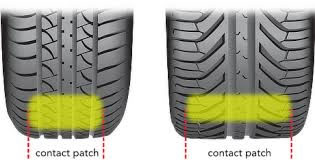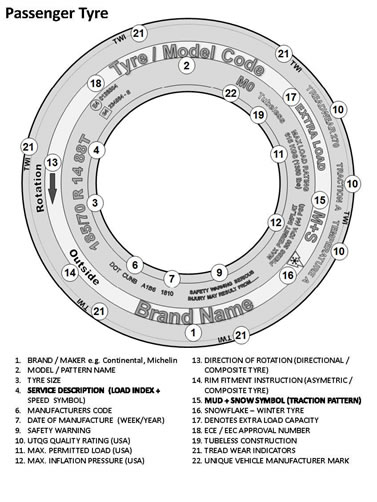TYRE CARE
Looking after your tyres

The only contact your vehicle has with the road is through its tyres. The total tyre contact area for an ordinary car, trailer, caravan and motorhome is very small as you see from the graphic above. It is therefore essential you have the correct tyres fitted and they are inflated to the correct pressure. They must also be roadworthy and regularly inspected for damage and wear minimum tread depth is 1.6mm as it is through the tyres that you are able to accelerate, brake, corner and steer safely.
The tyres that are fitted to your trailer, caravan or motorhome have been specifically chosen by your vehicle manufacturer to take account of the vehicle and its loadings. The tyres have heavy demands placed on them and are the key safety component of your vehicles.
For Your Campervan or Motorhome -
When you wear out a pair of tyres on a motorhome or campervan, particularly where the powertrain is front wheel drive, consider having the new tyres fitted to the back axle and bring the older slightly worn rears to the front. This will then have your newest and better pair of tyres on the rear axle where they can control the vehicle better. This advice is now given by many tyre manufacturers and driving organisations and it is considered good practice to fit your best tyres to the back axle. Always consult the vehicle handbook though, as some manufacturer recommendations may differ from that described above, for example some all-wheel drive vehicles need the tyres to be rotated periodically to keep the wear even.
Winter tyres provides higher levels of grip on ice, cold, wet or damp road surfaces. As a result they provide higher levels of grip on snow or ice. Winter tyres are marked on their sidewall with a snowflake motif inside the outline of a mountain peak

Load and speed
All tyres are marked with a series of codes to tell you the maximum load they can carry and their maximum speed rating.
Many vehicles are fitted with tyres with a speed rating higher than the legal limits - if a speed rating is lower than the legal limit then the tyre's limit takes precedent. Vehicle tyres are often supplied with a load carrying capacity in excess of the maximum permitted for the chassis. When you are looking for replacement tyres seek advice from the suppliers and avoid going to a lower speed or load index unless you are sure the tyres can still cope with your demands. Taking a tyre beyond its weight limit is overloading which renders the vehicle illegal and potentially unsafe.
Caravans and trailers do not generally use special trailer tyres, they are often the same as those used on light commercial vehicles.
The highest speed allowed for towing in this country is 60mph but can be higher in some other countries. The weight dictates the speed limits that should be adhered to. Older caravans may have been originally supplied with tyres that on paper were under-rated, which is due to something known as the bonus load, where a tyre's load capacity may be increased by 10 per cent when the speed was restricted to 62mph.
If the bonus load is taken into consideration then a tyre with a load index of 80 (450kg per tyre) can carry 900kg plus ten per cent bonus load making a maximum total of 990kg - subject to a strict maximum speed of 62mph. For safety reasons the caravan industry has moved away from this practise and it's quite common to find a modern tourer running higher load capacity tyres where the maximum technically permitted laden mass (MTPLM) of the caravan does not exceed 90 per cent of the combined tyres - load capacity.
Tyre pressures

Have you checked your tyres and wheels?
It is the air pressure inside the tyre that supports the load and therefore inflation pressures are dictated by the load upon the tyre. You will find the recommended tyre pressure for your car, motorhome, caravan or trailer in the owner's manual. You should always adhere to the pressures given in your handbook.
Always check pressures when the tyres are cold as the pressure will rise rapidly after only a few miles due to the heat generated. Under-inflated tyres are a major concern, as they can overheat in operation and in the worst case scenario fail. Over inflation can cause a poor or unstable ride and uneven wear characteristics. Over inflated tyres are also more prone to impact damage as they are less able to absorb road shocks.
Generally, tyre pressures for caravans and trailers are higher than when the same tyre is to a car, which reflects the higher load placed upon them.
Motorhomes may have different axle loads from front to back and therefore the tyre pressure will need to be adjusted to suit, the chassis handbook should offer guidelines. Trailer wheels are normally smaller than those found on caravans and cars and often require higher pressures to enable them to support the weight on the axle.
If the required tyre pressure exceeds 60psi then a metal stem and high pressure valve cap are recommended. It is important to tell the supplier of a new tyre the operating pressure so the correct valve is fitted.
Some car manufacturers often advise raising tyre pressures when carrying a full load, particularly on the rear axle. Large SUV-type vehicles may not need a significant tyre pressure change when towing but more conventional cars may well need an increase as the load on the hitch can be quite significant. This information should be on the car as per the graphic above.
If you are unsure what pressures your car tyres should be, contact a tyre specialist or the vehicle manufacturer.
If you intend towing at the higher speed limits permitted abroad then you may need to adjust the tyre pressures on your unit and reduce the tyre. If in doubt, check with your trailer manufacturer or tyre specialist.

